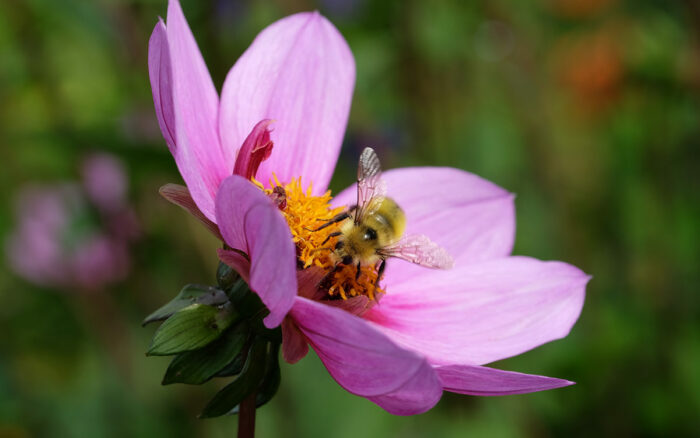
We gardeners are becoming more aware of our changing world, not just the climate but also the habitat reduction for pollinators. Landscape designers are becoming more aware and responding by adding more pollinating plants to designs. How to integrate more pollinating plants into a mature garden is a bigger challenge. Here is a short list of simple but effective ways to help pollinators survive and be useful in our gardens:
- Provide habitat, nesting places, and host plants.
- Provide flowering shrubs, perennials, and annuals that will attract pollinators, give them nectar and pollen, and provide places to raise their young.
- Watch out for any insecticides or herbicides. Use safe products that will not harm pollinators. Use targeted herbicides, not broadcast herbicides.
- Plant unused corners and spaces with a wildflower pollinator mix.
- Add pollinating flowers to veggie gardens or orchards.
- When something dies in your mature garden, replace it with something that is beneficial to all types of pollinators.
- Plant for 12 months of blooms.
Get to know your local pollinators first, then the plants they love
Before you start adding plants to attract them, you first you must familiarize yourself with the various types of pollinators. Many of us think of hive bees first, but there are many different types of pollinators that work in our gardens: beetles, flies, butterflies and moths, and native bees. But bats, birds, and even lizards also act as pollinating animals. We’ll focus on the insect pollinators below.
Insect pollinators
Beetles: In the Pacific Northwest region, these pollinate native populations of magnolia (Magnolia spp., Zones 3–9) and tulip tree (Liriodendron spp., Zones 4–9) as well as small flowering cluster flowers like asters (Aster spp. and cvs., Zones 3–9), spirea (Spiraea spp. and cvs., Zones 4–8), and goldenrod (Solidago spp. and cvs., Zones 2–9). If you already have these plants, you’ve got a good start on attracting more.

Butterflies and moths: These need host plants for their larvae and nectar plants to feed on. Specific butterflies often need specific types of plants as hosts; if you don’t have these plants already, they can be added to a vegetable garden or little-used corner of the property not cultivated yet. This way, if you’re worried about holes in leaves from hungry caterpillars, those host plants won’t be front and center. Many common butterfly flowers have their nectar hidden deep within the flower and are either borne in clusters or have a lip that serves as a landing pad for the butterfly to perch on. A good example of this is bee balm (Monarda spp. and cvs., Zones 3–9).
Flies: Surprisingly, these are the second most common pollinator in the world. They are often hard to distinguish from bees because their bodies mimic bees as protection from predators. Less picky about types of flowers, they go about their business with great efficiency.
Bees: There’s no denying how important bees are for pollinating much food production, including the edibles we grow in our own gardens. Providing attractive bright annuals can attract them to your garden. Adding cluster-type flowers like sweet alyssum (Lobularia maritima, annual) to the edges of beds can be beautiful and useful for pollinators.
Be sure there is adequate shelter for your pollinators—especially native bees
There are several types of bees. Most gardeners don’t have bee hives, so learning how to attract bee populations already in existence is a great way to get started. Solitary bees (often native) live in the ground and hollow logs, so ensuring there are some of these scattered about your property (if possible) is a good idea. Social bees, such as bumblebees, live together in a colony that overwinters underground and emerges the following spring to start new colonies. This is critical when it comes to delaying spring cleanup in the garden. Cuckoo bees are the lazy ones who do not build nests or forage for pollen but lay their eggs in the nests of other bees and allow them to raise their young. Although I don’t have any specific tips on attracting these parasitic bees, it’s important to know that they have their role to play in the bee community too. Mason bees are an easy way to start the pollinator process, since these colonies can be purchased by reputable sellers. The nesting material (such as various reed grasses) you provide for your new garden guests can also attract the native bees in your area.
One thing many gardeners don’t think about is nesting places for all of these pollinators. The mature garden provides much in the way of habitat for nesting, overwintering, and food storage. Leaving a pile of debris, especially things with hollow stems, twigs, and dry grasses, is a great way to create that type of habitat. Bees and beetles often use decaying logs to build homes and store food. Pruning out mature shrubs to create more light and air creates habitat for ground-nesting bees who need warm soil to thrive.
|
|
Mason bees can be purchased by reputable sellers and are an easy way to jump-start the pollinator population in your yard. Be sure to provide them (and other pollinator friends) with plenty of nesting material so they stay happy and healthy. This is a short clip of mason bees in my garden. Video: Susan Calhoun
The key to getting more pollinators is succession of blooms
Once you’ve assessed which pollinators are prevalent in your area, what sort of food sources you have already, and what sheltering materials/habitats you can introduce, it’s time to talk new plants. There are innumerable native plants that are used by our regional pollinators and can be added easily into various locations in a mature garden. Color, shape of flower, and bloom time should vary widely when you it comes to selecting plants. Early-blooming plants are extremely important because food sources are slim at that time of year in the Pacific Northwest. Plants like mahonia (Mahonia spp. and cvs., Zones 2–9) and early spring-blooming bulbs are good options to add and, in the case of bulbs, are easy to sneak into small spaces in an already full bed.
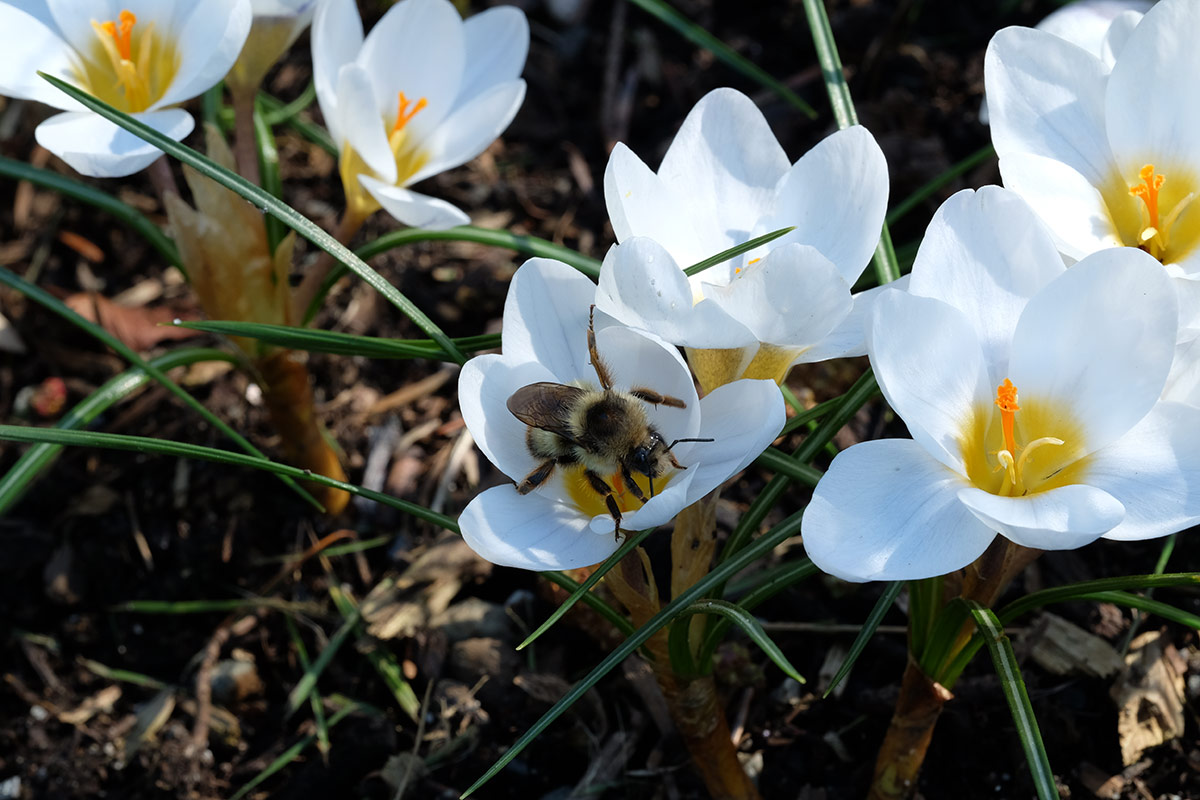
A bit later in the season it can be hard to find blooms that will blend seamlessly into an existing color scheme. Common yarrow (Achillea millefolium, Zones 3–9) can be a bit weedy, but I’ve found that a cultivated variety like ‘Lilac Beauty’ or ‘Fireland’ can blend into a garden politely and the bright colors attract scores of bees and butterflies. Even easier to incorporate is creeping yarrow (Achillea × kellereri, Zones 4–8), which is a low-growing ground cover that can fill in gaps within a mature garden. It is also low enough for beetles to enjoy it. These are just a very few examples of helping our pollinators to hang out in our gardens.
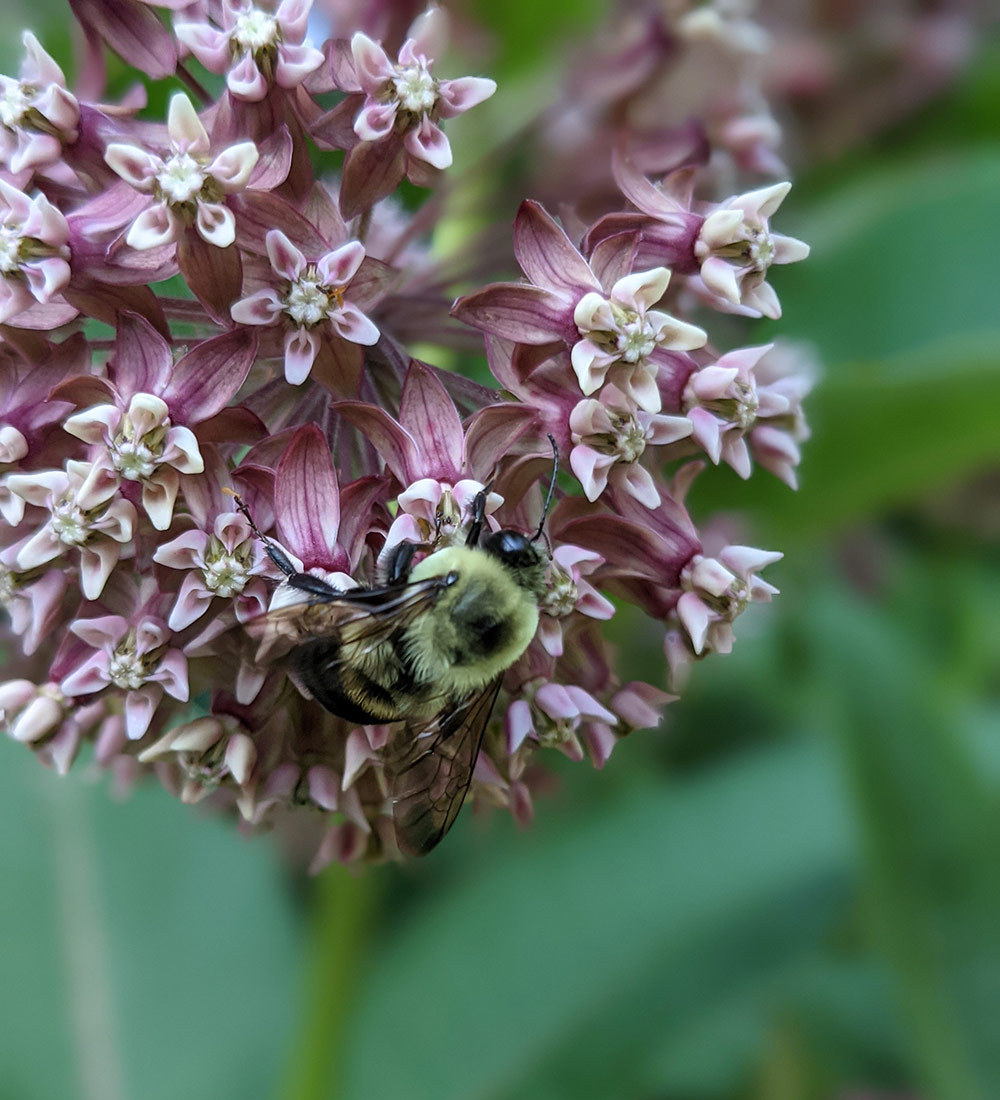
Read more about pollinators
Tour a Beautiful Eco-friendly Front Yard Garden with a Succession of Blooms
Important Pollinator Host Plants
Pollinators’ Favorite Nectar Plants
Additional resources
Xerces Society has wonderful region-specific plant lists to help with knowing what to plant.
Susan Calhoun is the owner of Plantswoman Design in Bainbridge Island, Washington.
Fine Gardening Recommended Products

isYoung Birdlook® Smart Bird Feeder with Camera
Fine Gardening receives a commission for items purchased through links on this site, including Amazon Associates and other affiliate advertising programs.
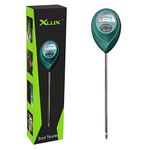
XLUX Soil Moisture Meter
Fine Gardening receives a commission for items purchased through links on this site, including Amazon Associates and other affiliate advertising programs.
- Simply insert the moisture meter into soil and you'll get the test result instantly
- Single probe, less hurts to the roots, doesn't dig up too much soil after test
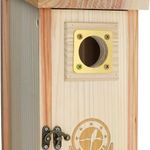
Bird Houses for Outside Clearance with Copper Guard, Cedar Bird House Outdoor, Bluebird Finch Swallow Wren Chickadee
Fine Gardening receives a commission for items purchased through links on this site, including Amazon Associates and other affiliate advertising programs.


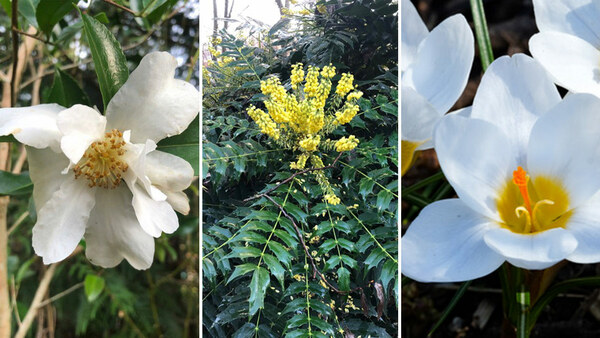
















Comments
Log in or create an account to post a comment.
Sign up Log in